JAPANESE EMPEROR AND IMPERIAL FAMILY
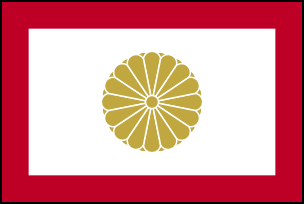
Imperial flag The Japanese Emperor is the occupant of the Chrysanthemum Throne. The Emperor' standard is a gold chrysanthemum on a red field. Only the Imperial family is allowed to use the 16-petal chrysanthemum crest on it tea cups, towels and other items. Sometimes the chrysanthemum symbol with a purple background is seen other places: at Shinto shrines, on the shrine above the ring at sumo tournaments and on nationalist flags.
The Emperor is never addressed a "Your Highness." He's always "Your Majesty." He and the Empress don't have last names. The Regalia of the Emperor (The Three Treasures) includes the sacred mirror (kept at Ise Shrine), the curved jewel and the sacred grass cutting sword (kept at Atsuta Shrine in Nagoya). According to legend they were given to the Imperial family by the sun goddess Amaterasu. They are symbols of the Emperor's power and authority.
The Japanese monarchy has been around for at least 1,300 years, but, with the exception of a few hundred years, the Emperor has had little power and has primarily been regarded as a symbol of the nation. The symbolic status of the modern Emperor is not all that different than the status of the Emperor during the long period when Japan was ruled by shoguns. The emperors had power during the period in which Japan became a nation and the period between the Meiji Restoration and the end of World War II.
Imperial Household Agency Website: www.kunaicho.go.jp/. It offers photographs, speeches and information relating to the Imperial family and traditional Japanese culture. There are a dozen or so other sites devoted to the Imperial Family.
Websites and Resources
Links in this Website: JAPANESE EMPEROR AND IMPERIAL FAMILY Factsanddetails.com/Japan ; JAPANESE EMPEROR’s DUTIES AND LIFESTYLE Factsanddetails.com/Japan ; EMPEROR HIROHITO Factsanddetails.com/Japan ; EMPEROR AKIHITO AND EMPRESS MICHIKO Factsanddetails.com/Japan ; CURRENT JAPANESE ROYAL FAMILY Factsanddetails.com/Japan ; PRINCESS MASAKO Factsanddetails.com/Japan
Good Websites and Sources: Imperial Household Agency kunaicho.go.jp/eindexList of Emperors of Japan friesian.com ; Heraldica.org article on the Japanese Emperor heraldica.org ; History on Unofficial Japan Royals Pagesetoile.co.uk ; Stanford SPICE links to articles (compiled in 2004) spice.stanford.edu ; Japanese Creation Myth Washington State University ; ; Wikipedia article on the Emperor of Japan Wikipedia ; Opening Imperial Tombs msnbc.msn.com ; Book: Secret History of the Yamato Dynasty prnewswire.co.uk Modern Imperial family The Royal Forums on the Imperial Family of Japan theroyalforums.com ; Royalty/nu Links royalty.nu/Asia/Japan ; Imperial Family of Japan Blog imperialfamily.blog54 ;Unofficial Japan Royals Pages etoile.co.uk
Imperial Palace in Tokyo Wikipedia Wikipedia ; Imperial Household Agencysankan.kunaicho.go.jp ; Map /gmap.jp Good Article by Robert Poole, National Geographic, January 2001. Imperial Palace in Kyoto Imperial Household Agency sankan.kunaicho.go.jp ; Kyoto Travel Guide kyoto.travel Shugakuin Imperial Villa: Imperial Household Agency /sankan.kunaicho.go.jp ; Photes japannet.de ; Wikipedia Wikipedia Katsura Imperial Villa: Wikipedia Wikipedia ; Imperial Household Agency sankan.kunaicho.go.jp ; Tour of Katsura Rikyu katsura-rikyu.50webs.com Katsura Rikyu ranked No. 2 as the best garden in Japan by the U.S. publication the “Journal of Japanese Gardening” . The gardens at Adachi Museum in Yasugi Shimane have been ranked No. 1 for four consecutive years. Ise Shrine Isejinguisejingu.or.jp ; Wikipedia Wikipedia ; Wikitravel Wikitravel Map: Japan National Tourism Organization JNTO and Ise area JNTO ; Ise Jingu isejingu.or.jp Udo Jingu Shrine (near Nichinan 20 miles south of Aoshima In Miyazaki Prefecture) is located in a large sea-eroded cave on the Pacific Ocean at the tip of Cape Udo. It is dedicated to the mythological father of the mythological first emperor of Japan.
Japanese Emperor
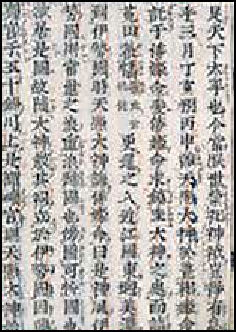
Nihon Shoki The Japanese Emperor is a member of the world's longest ruling dynasty. Although there is no historical documentation that proves the dynasty began 2,600 years ago with Emperor Jimmu, as is claimed, there is proof that it has been around since the A.D. 7th century. The early Yamato leaders of Japan claimed descent from the sun goddess, Amaterasu. The title of emperor (tenno) was introduced around the 5th century.
The British monarchy dates back to around the A.D. 6th century and the Chinese imperial throne goes back to around 1500 B.C. but each of them were comprised of different dynasties made up of different families, sometimes from different places. Members of the Japanese monarchy, by contrast, have belonged to a single family.
Historians believe the emperor system probably goes back even further than the 7th century. The first emperor was the legendary Jimmu Tenno. It is not known whether Jimmu actually existed, was a composite of several figures or was a complete fabrication. The dates attributed to Jimmu's reign, 660 B.C. to 585 B.C., are impossibly early and arrived at arbitrarily in the 8th century historical record, the “Nihon Shoki”. If Jimmu existed he probably lived between 40 B.C. and 10 B.C. The present emperor, Emperor Akihito, is considered the 125th descendant in line from Emperor Zinmu.
Japanese Creation Myth
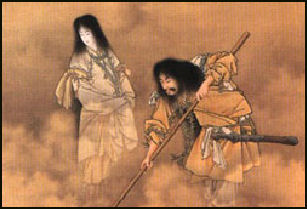
Early Japanese history and religion are intertwined. According to the Japanese creation myth described in the ancient chronicles, the “Kojiki” (A.D. 712) and “Nihon Shoki” (A.D. 720), creation began with negative and positive forces coming together and forming an egg-shaped mass with light elements rising to create the heavens and heavy elements falling to form the Earth. The islands of Japan were created by the god Izangi-no-Mikoto (“Male Who Invites”) and the goddess Mikoto-no-Izanami (“Female Who Invites”) separate and apart from the rest of the world when the Heavenly Jeweled Spear was thrust into the ocean from the Floating Bridge of Heaven
Sea water dripping from the spear coalesced into the island Onogoro-jima where the god and goddess lay together producing the islands of Japan along with eight million natural deities (“kami”), including ones for mountains, rivers, trees, crops and other natural things.
Izanami gave birth to 35 gods but was badly burned and died after giving birth to the fire god. Izanagi followed her into the land of the dead to retire but changed his mind after seeing Izanami disfigured with “putrefying matter” and “maggot swarms” and ran away. He was pursued by 80 Ugly Females and escaped by placing a boulder between the lands of the living and the dead. After returning to the world of the living he purified himself in a stream and gave birth to more deities, including the Sun Goddess Amaterasu Omikami, moon good Tsukuyomi-no-Mikito and the ocean god Susano-o-no-Mikito, who were created by washing his right eye, left eye and nose.
Some scholars see some Chinese influences in the myth such as the yin-and-yang like quality of the positive and negative state of the universe in the beginning of time. Some have argued the whole thing was way too abstract for it be truly Japanese in origin. Aspects of the myth that have been described as distinctly Japanese include the way things sprung up through spontaneous creation and sexual generation and the emphasis on purity and the distaste for things that are polluted or dirty.
Creation of the Japanese People and the Emperor

Amaterasu Omikami ("Great Heaven-Illuminating Diety") ruled the High Plain of Heaven but descended to a cave plunging he world into darkness, after quarreling with Susano, who played a number of dirty tricks on her including placing some excrement on her throne in her new palace. She remained in the cave until she was lured out by the obscene dancing of the “kagura” dancer and the god Ame-ono-Uzume and light was restored. Later Japan was given to Susano-o's son Okuninushi who passed it on to Ninigi, Amaterasu Omikami’s grandchild.
Amaterasu Omikami is most important Japanese deity. The rising sun on the Japanese flag symbolizes the special relationship between the sun (Amaterasu) and Japan. Because the rest of the world is reliant on the sun, Japan theoretically has power over it.
Amaterasu Omikami is the supreme being of Ise Temple, Japan’s most important religious facility. She is credited with creating the Three Treasures (mirror, sword and jewel)’symbols of the Emperor's power and authority.
The creation of the Japanese people began when Ninigi descended to the lower realms of the heavens. He took with him what became the three imperial regalia’a curved jewel (magatama), a mirror, and a "sword of gathered clouds" — and ruled over the island of Kyushu. His great grandson Jimmu Tenno was the first emperor of Japan. He set out to conquer Yamato. On the main island of Honshu, according to tradition he established the unbroken line of imperial descent from the Sun Goddess and founded the Land of the Rising Sun in 660 B.C. Members of the House of Yamato, the imperial family that unified the islands of Japan and are still around today, are purportedly Jimmu's decedents. [Source: Library of Congress]
For centuries, Japanese children learned the Japanese creation myth as if it were historical fact. The Yamato clan, probably arrived from Korea or China, or possibly Pacific islands to the south. Some historians theorize that belief in the Sun Goddess was introduced by sun worshipers from Korea or China. Among sun worshipers, throughout history and around the globe, high positions were often held by priestesses. Some historians have speculated that the first Japanese Emperor, Jimmu Tenno, was the offspring of one of such priestess and an invading chieftain.
The belief that the Emperor was the Son of Heaven and the impact of this belief on Japanese political life can be traced back to the Taika reforms in A.D. 645. Versions of Japanese creation myth which forms the basis of Shintoism are found in the “Kojiki” (A.D. 712) and “Nohon Shoki” (A.D. 720).
Imperial Concubinage in Japan
The idea that the Japanese Imperial family is an unbroken dynasty of blood relatives is a myth. Until the 1920s, the royal line was sustained through a system of concubinage in which each emperor was assigned 12 to 50 concubines from ambitious aristocratic families (which also provided the legal wife).
In imperial times polygamy was not uncommon and high-ranking aristocrats sent their daughters to the palace to be married for political and social reasons. Aristocrats often wanted to have many daughters in the chance that one could become the wife of the Emperor and bear him a son and increase the aristocrat’s power. Many of the wives and lovers of the Emperor became nuns when they were no longer in favor.
Murray Sayle wrote in the New Yorker, "At the risk of some inbreeding, concubinage insured that a suitable crown prince was almost always available to succeed a deceased emperor, and the imperial continuity was thus guaranteed...What continued under this arrangement was not a real family but an office of emperor, passed along like a precious parcel naming powerful clans...whose intrigues, futon-hopped and brought up one another's children." [Source: Murray Sayle, the New Yorker, June 12, 2000]
Sayle wrote, "Whenever the question of a successor arose, the emperor would drop a silk handkerchief at the feet of the mistresses on duty. The resulting children were brought up not in the Imperial household but by the families who had volunteered their daughters; in this way collateral branches of the imperial family were founded, from which new emperors could descend."
About half of Japan’s emperors are thought to been born from concubines The Meiji Emperor and his son the Taisho Emperor were both the son’s of concubines. Hirohito and Akihito were the offsprings of legal wives. Hirohito abolished concubinage in 1924, the year he got married to the future Empress Nagako. In 1921 he visited England, where he was informed King George V, of the straight-laced British royal family, "No geisha's here, I'm afraid!"
The 39 concubines still employed by the Imperial Household when concubinage was outlawed in 1924 were commended for their public spirit and given a pension and laid off. There was some discussion of reviving the concubine system after Nagako gave birth to four girls in a row but those discussions ended when Akihito was born in 1933.
Male Succession to the Japanese Throne
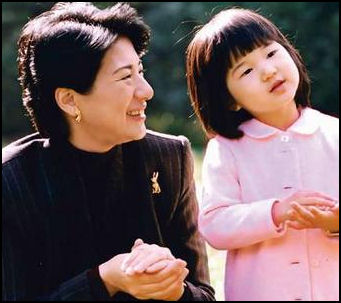
Princess Aiko can't be Empress “Tenno”, the Japanese word for Emperor, means "Son of Heaven." According to Article 1 of the Imperial Household Law, passed by the Japanese parliament in 1947 and supported by the Japanese constitution, the throne can only be claimed by male descendants of the emperor, his brothers or uncles. Article 2 of the Constitution reads: “The Imperial Throne shall be dynastic and succeeded to in accordance with the Imperial House Law.” A male-only succession law was first passed in 1889. The Imperial Household Law also states that female members of the Imperial family lose Imperial status if they marry outside the Imperial line.
At the end of World War II, there were eleven collateral branches of the Imperial family and 51 Kyoto aristocrats with enough royal blood to be considered as possible candidates for the Emperor. The Imperial Household was passed to avoid confusion and prevent manipulation of the Imperial throne by the Japanese aristocracy and reduce the chance than the throne would be claimed by an emperor with political and military ambitions.
After Princess Aiko was born in 2001 and no male heir had been produced since the 1965 there was some debate about amending imperial succession law to allow women to ascend to the Imperial throne.
Why Females Can Not Ascend to the Japanese Throne
Why can't females ascend to the throne? Central to the Emperor’s claim to the throne is the fact that the Emperor is a male descendant of the Sun Goddess and questioning this assumption would undermine the Imperial family’s claim to the throne. There is also the fact that a symbolic sexual union took place between the Emperor and the Sun Goddess that reportedly is re-enacted in an important ritual that takes place after the Emperor ascends to the throne.
The male lineage tradition comes to an end if there are no male members. If there are no male heirs when an emperor dies, Sales wrote, “a reigning empress would have to have a husband, or the imperial line would end with her. To avoid inbreeding her husband would have to be from different non-royal family."
Between 592 and 1770, there were eight female emperors who ruled when there were no sons, or boys were too young to rule. Two of them reigned twice. The last women to serve as a reigning Empress was Gosakuramacho (Empress Shotoku) who reigned from 1762 to 1770. She wasn't allowed to have kids.
The reigning Empresses acted as "relief emperors" until male successors came of age and were widows or unmarried to avoid having the Imperial succession changing to the matrilineal side. They are credited with accomplishments such as creating Japanese currency and completing two of Japan's most important literary and historical records.
Reforming Japan’s Imperial Household Act
In May 2001, six opposition lawmakers (all women) in Parliament established committee to study how to revise the 1948 Imperial Household Act so that women could ascend to the throne. A trip by palace officials to Holland and Denmark gave birth to rumors that Japan break the tradition and allow a women to succeed the throne.
In a survey in 2005, 73 percent of Japanese that responded said women should be allowed to become emperor. If a woman were to become a reigning Empress a few key details would have to be worked out: How would males and females in line be ranked? Would males have precedence over females? Would immediate family members have precedence over uncles and cousins. One proposal was the Emperor’s first-born child, whether male of female, be allowed to ascend the throne. Another proposal called for a women to take the throne only if no suitable male heirs’sons of the Emperor were available.
In October 2005, a Japanese government panel on Imperial Succession recommended that female members of the Imperial family be allowed to ascend to the throne to maintain a stable succession and the Emperor’s first-born child be given priority regardless of sex.
In the mid 2000s Prime Minister Koizumi suggested changing the constitution to allow women to become Emperor and backed a bill for revising the succession law to be introduced to the Diet. Many conservative members of the LDP and ultra-rightist opposed the move and held rallies and got the signatures o 173 lawmakers who opposed te changes on a petition.
All talk of changes to the Imperial Household act and a female monarch ended when a new prince — and male heir to the throne — was born to Prince Akishino, the Emperor’s second oldest son, in September 2006. Prime Minister Abe decided to ignore recommendations of the government panel on Imperial Succession and shelved plans for presenting a bill to parliament on the matter.
Allowing Imperial Status for Commoner Husbands
In January 2012, the Yomiuri Shimbun reported, the government will likely grant Imperial status to commoner husbands of female Imperial family members who lead their own family branch so they can engage in official duties similar to those of Imperial family members, according to government sources. The change would, for the first time in history, pave the way for male commoners to join the Imperial family. The government plans to submit a bill to revise the Imperial House Law to an extraordinary Diet session in autumn. [Source: Yomiuri Shimbun, January 3, 2012]
During discussions on the revision of Article 12, some government officials said it is also necessary to revise Article 15, which stipulates, "Any person outside the Imperial family and his or her descendants shall not become a member thereof except in the cases where a female becomes Empress or marries a member of the Imperial family." The officials said the revision is needed so a male commoner who marries a female Imperial family member can be given Imperial status.
Currently, male commoners who marry into the imperial family are not granted Imperial status, but they likely will be required to engage in official duties such as participating in Imperial family events and going on domestic inspection tours as commoners-turned-princesses do.
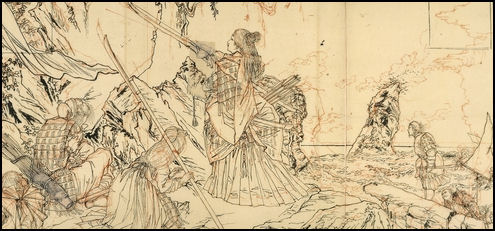
Allowing Females to Create New Imperial Family Branches and Ascend to the Throne
The government is currently discussing a plan to allow female Imperial family members to create new family branches by maintaining their Imperial status after marrying outside the family. Creating an Imperial family branch led by a female member would require amending the Imperial House Law so that a female member would remain in the imperial family after marriage. This issue is inextricably linked to the stable succession to the imperial throne. Article 12 of the Imperial House Law stipulates that if a female of the imperial family marries a commoner "she shall lose the status of imperial family member."[Source: Natsuki Komatsu, Yomiuri Shimbun, November 26, 2011]
To consider the expansion of heirs entitled to assume the throne, a full-scale amendment of the Imperial House Law including Article 1, which stipulates only male heirs from the male line of the Imperial family can accede to the throne, is necessary. Such discussions are time-consuming and may raise different questions on the succession system. The expansion of the range of heirs entitled to the throne to female members of the Imperial family was discussed immediately after World War II, but no decision was reached due to time constraints.
The Emperor has been very concerned about the instability of the current Imperial ascension system and a decrease of Imperial family members. If the current situation continues, the heavy responsibility of producing a future heir to the throne is likely to rest on only Prince Hisahito and his spouse. Another concern is a lack of Imperial family members to support Prince Hisahito and his spouse in the future. However, reviewing the Imperial household system is both a political and legal issue as Article 4 of the Constitution stipulates the Emperor should "not have powers related to government." As the Emperor considers observation of the Constitution a priority, he has refrained from offering an opinion.
During the process of drawing up its constitution, the Meiji government considered making it possible for a female member of the Imperial family to take the throne. The possibility was also discussed by the Imperial Diet just after the end of World War II. In November 2005, an advisory panel to then Prime Minister Junichiro Koizumi submitted a report that proposed female members of the Imperial family be allowed to create family branches upon marriage, and that they or their descendants be able to assume the throne.
In March 2012 the government held its first hearing on the issue at the Prime Minister's Office by meeting with journalist Soichiro Tahara and Akira Imatani, a Japanese culture professor at Teikyo University. The two expressed their approval of female branches of the Imperial family. "According to to a Yomiuri Shimbun poll, 64 percent of respondents supported an idea to allow female members of the Imperial family to create a new family branch by maintaining royal status after marrying outside the family, with only 20 percent disagreeing with it. [Source: Takeshi Okimura and Katsumi Takahashi, Yomiuri Shimbun, March 2, 2012]
Reforms and the Current Royal Family
The main point of contention of proposed reforms will be whether to limit the number of female members eligible to create their own branches to an emperor's daughters and granddaughters, and whether men married to female Imperial members and their children should gain royal status.
The Imperial family currently comprises the Emperor and 22 other members, with four of the seven male members in their 60s or older. There are eight unmarried females in the Imperial family, including three granddaughters of the Emperor: Princess Aiko, 9, the only child of Crown Prince Naruhito and Crown Princess Masako; and Princesses Mako, 20, and Kako, 16, two of the three children of Prince Akishino and Princess Kiko. The five other unmarried female members are all granddaughters of Prince Mikasa, brother of Emperor Showa. The eldest is 29-year-old Princess Akiko. [Source: Yomiuri Shimbun, November 26, 2011]
In October 2011, Shingo Haketa, the grand steward of the Imperial Household Agency, asked Prime Minister Yoshihiko Noda to consider creating an Imperial family branch led by a female member as an "urgent matter" because it is currently a top priority for the future to have the option of a female Imperial family member acceding to the throne. This is because Haketa felt a sense of urgency as the Emperor's first granddaughter, Princess Mako, was nearing her 20th birthday on Oct. 23 and only Princess Aiko, 9, and Princess Kako, 16, would remain as minor female members of Imperial family.
The Emperor is worried about the future of the Imperial family. Nine of the 22 members of the Imperial family are aged 30 or younger. All nine, except for Prince Hisahito, are unmarried women or girls. When these females get married, they will leave the Imperial family. As a result, the number of Imperial family members will steadily decline. In the near future, serious concerns will arise over the stability of Imperial Household activities.
In September 2006, Prince Hisahito was born to Prince Akishino and Princess Kiko as their eldest son. A bill to revise the Imperial House Law, which would have allowed women of the Imperial family and descendants from female lines to assume the throne, was being prepared at the time, but the government decided not to submit it to the Diet. Discussions over the Imperial succession ceased. [Source: Yomiuri Shimbun, November 27, 2011]
Currently, there are nine Imperial family members who are aged 30 or younger. One of them is Prince Hisahito. The other eight are all unmarried women or girls. On Oct. 23, Princess Mako, the eldest daughter of Prince and Princess Akishino, marked her 20th birthday, meaning six of the eight female members have become adults. If the female members lose their membership in the Imperial family upon marriage, it will be impossible for them to create new family branches. This could result in a situation in which only a few Imperial family members are left to support Prince Hisahito.
Japanese Emperor as a God
Up until the end World War II, most Japanese thought of the Emperor as a God. It was also widely believed that he not only represented Japan but was Japan. Into the 19th century, people spoke in archaic, imperial form of the Japanese language when talking about the Emperor that has now largely disappeared.
The Emperor’s divine status before World War II was not so much the result of some ancient belief but rather a manifestation of late 19th century politics. Inspired somewhat by European Christianity and European monarchies, reformers in the Meiji Period (1868-1912) revived the pontifical role of the Emperor when it made Shinto the state religion as a way of unifying Japan. The reformers then went a step further and made the Emperor commander and chief of the military and the preeminent leader of Japan's political structure. Military leaders were directly responsible to the emperor, who also had the power to appoint and reject generals, admirals and prime ministers.
By the 1930s the authority of the Emperor was unquestioned. Every student in every Japanese school bowed before the Emperor’s photograph every morning and teachers described how the first emperor descended from the gods as if it were historical fact.
The Emperor and other royals were not allowed to touch money or be photographed or even looked at by ordinary people. Criticism of the emperor was unheard of. Any one that ventured to say anything bad about him risked a long prison term or even death.
Emperor After World War II
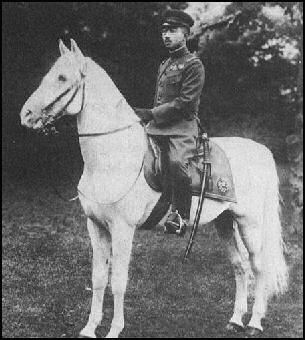
Emperor Hirohito The Japanese constitution, instituted in May 1947, after World War II, demoted the Emperor from a "living god" to a "symbol of the state” and a “unifier of the people.” The Emperor was stripped of his political and diplomatic power and was recast as a symbol of new democratic, postwar Japan. Although Hirohito renounced his divinity he was careful not to deny that he was a descendent of the Sun Goddess. Without that he would have no claim on the throne.
The Emperor has no powers related to the government. Most parliamentary systems are formally headed by a king or queen. At the end of the World War II, it was decided that it would inappropriate to name the Emperor as the head of state in the new Constitution and the position was left vacant.
The legal status of the Emperor is defined by the Japanese constitution in Article 1—“The Emperor shall be the symbol of the State and of the unity of the people, deriving his position from the will of the people with whom resides sovereign power” and Article 4—“The Emperor shall perform only such acts in matters of state as are provided for in this Constitution and he shall not have power related to government.”
One Japanese official told the New York Times, "We don't really have a head of state. I mean there's the Emperor, of course, but there's no head of state. When we need a head of state we bring the Emperor out. So he's head of state when we need a host for a state visit, But he's not really head of state."
The prime minister takes office when he is handed his commission by the Emperor.
Emperors, World War II Apologies and Right Wing Extremists
People from many nations around the world want the emperor to publicly apologize for the atrocities committed by Japan in World War II. Deftly dodging the apology issue the Emperor once wrote: "In World War II, many lives were lost, many people were wounded and many people suffered. My heart grieves deeply because of this."
Many conservative Japanese still regard the Emperor as a god. The right-wing Showa Restoration Society, named after the formal name of Emperor Hirohito's reign, believed that the Emperor should be reinstated as the God-like head of the Japanese government. In 2002, a member of a right wing group told the New York Times, the Emperor is “the intermediary between heaven and earth. Culturally, holy people, sacred people, are not to be seen in public, not to be talked about.”
The press, organizations and ordinary people don't criticize the Imperial family mostly out of respect but also out of fear of being hounded nationalist groups with their blaring horns and their trucks.
In September 2008, a former Japanese soldier fired an explosive device into the Imperial Palace but one was hurt. The devise — a gunpowder filled fire extinguisher — was fired from a road in Chiyoda Ward and was made with readily available material such as a fertilizer and built using information learned from a video-sharing Web site.
Support of the Japanese Emperor
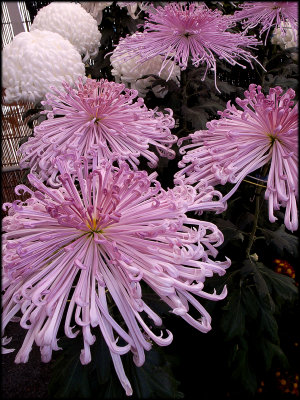
chrysanthemums According to one poll 80 percent of Japanese back the role of the Emperor as a symbol of the nation. The popularity of the royal family peaked in the 1989 when a new Emperor was crowned and 1993 when there was a royal marriage.
Most ordinary people pay little attention to the Emperor. Most of those who are interested in him are in their 50s and 60s. Public comments on the private life of the Imperial family are taboo and the merest perceived slight to their dignity can result in angry protest by nationalist groups. This means people know very little about the Emperor and his family and therefor can't relate to them.
Explaining the enduring appeal of the Emperor, one politician told National Geographic, "This system provides stability in an uncertain world." Instability and chaos "doesn't happen here because the Emperor keeps things in balance. It's a part of what makes us Japanese...It may be wasteful to have this kind of system. But I would argue that this sort of waste is useful. The same thing can be said of culture and art. Without them we cease to be human. We become robots."
There has been discussion of having the Emperor lighten up a bit and do more ordinary things like the "bicycling monarchies" in Scandinavia. Hiroshi Takahashi, a royal watcher with Kyodo News said, "I think if we saw the Empress eating ice cream...or riding a bicycle people might well stop respecting” her. He said the royals have been "victimized and sacrificed, but somebody has to maintain the traditions."
Image Sources: Wikipedia, Ray Kinnane, Tokyo National Museum, Sydney Morning News
Text Sources: New York Times, Washington Post, Los Angeles Times, Daily Yomiuri, Times of London, Japan National Tourist Organization (JNTO), National Geographic, The New Yorker, Time, Newsweek, Reuters, AP, Lonely Planet Guides, Compton’s Encyclopedia and various books and other publications.
Last updated April 2012
